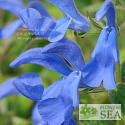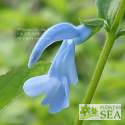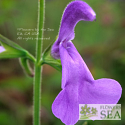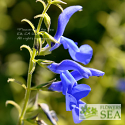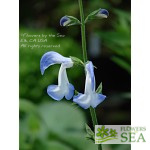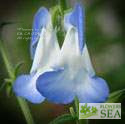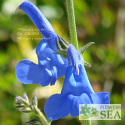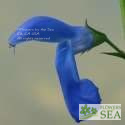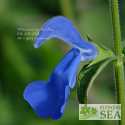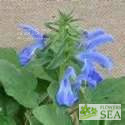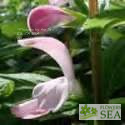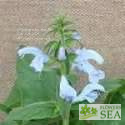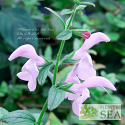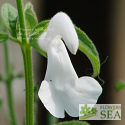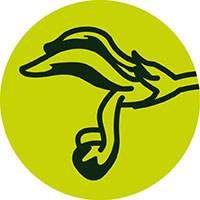 | It must have been the royal blue flowers of Gentian Sage (Salvia patens) that caught the eye of plant explorer Karl Theodor Hartweg, who discovered the species on an expedition to Mexico that began in 1836. The large, double-lipped blossoms look similar to an open parrot’s beak and are one of the truest blues found in nature. In contrast, the leaves of most Gentian Sages are an attractive bright green, but nothing to write home about. Or, in Hartweg’s case, they probably didn’t merit a crated journey by slow-going ocean vessel back to the U.K. Horticultural Society, which had hired the German botanist to explore Mexico’s treasure trove of flowering plants. By 1839, Scottish botanist Robert Marnock, who had previously become famous for designing London’s Sheffield Botanical Gardens, wrote exuberantly about the species in The Floriculture Magazine, and Miscellany of Gardening. Marnock said that Salvia patens was “exciting so much interest” throughout Great Britain. He added that everything said about the species couldn’t do justice to its “remarkably brilliant blue.” Unlike reds, yellows and other colors that contain red and yellow -- such as orange and purple -- birds and bees aren’t as attracted to true blue flowers. This appears to be the main reason that royal or gentian blue is a difficult color to find in flowers. Nature supplies more of what pollinators demand. Nevertheless, hummingbirds find their way to the rich nectar of Gentian Sages. Plant these sages in a Salvia garden with a broader range of colors, and they receive plenty of hummingbird attention. Although the popularity of the species is primarily based on its true blue varieties, other types of Gentian Sage have developed over time including whites, pale blues and pinks. Compact dwarf species are also available and are spreading the species’ popularity to shady patios. A number of Gentian Sages do fine in full sun, but all thrive in partial shade. Give them rich, well-drained soil and water regularly. Depending on size, they make handsome container plants, borders, path edging and groundcovers. Flowers by the Sea offers species for sun or shade as well as a full range of colors. |
(Blue Angel Gentian Sage) Since the 1838 discovery of this herbaceous species from Central Mexico, Salvia patens has been a mainstay of the perennial garden. Blue Angel is one of the smallest of the full-sized varieties.
(Cambridge Blue Gentian Sage) Cambridge Blue is one of the most famous varieties of Salvia patens, which was discovered in Central Mexico in 1838. Its powder blue flowers are delightful and cooling in the landscape.
(Dorset Lavender Gentian Sage) Large, deep lavender flowers shaped like parrot beaks make Salvia patens 'Chilcombe' distinctive in the Gentian Sage group, which is dominated by true blues.
(Giant Gentian Sage) What makes Salvia patens 'De Flores Gigantes' truly giant is the size of its true blue flowers. However, this variety from Argentina is tall as well.
(Dot's Delight Bicolor Gentian Sage) This sage turns heads, because its large, white and blue bicolored flowers make it a unique variety of Gentian Sage. Developed in the UK, Dot's Delight is less vigorous and less sun tolerant than other varieties of the species. This is our own tested seed strain of this rare plant.
(Guanajuato Giant Gentian Sage) At 3 inches long, the flowers of this Gentian Sage are the largest of any we grow. Guanajuato Giant is also unique for its tall, upright growth and heavily textured foliage. This is our own tested seed strain of this rare plant.
(Giant Gentian Sage) "Wow!" is what most people say when they see this large Gentian Sage from Central Mexico. Growing to 4 feet tall, it has long, graceful spikes of 3-inch deep, royal blue flowers that are highly visible and easily accessible to hummingbirds.
(Oxford Blue Gentian Sage) Only Salvia patens 'Blue Angel' comes close to the hard-to-believe, rich gentian blue of this sage from Mexico. Oxford Blue also grows taller and spreads wider than Blue Angel.
(Patio Deep Blue Gentian Sage) Patio Deep Blue is a handsome, dwarf variety of Salvia patens from Holland. It loves partial shade and has dusky, deep blue flowers that are larger than those of other Gentian Sages.
(Patio Rose Gentian Sage) Patio Rose is a lovely, dwarf variety of Salvia patens from Holland. It needs partial shade and is perfect for containers. The rose-colored flowers are larger than those of other Gentian Sages.
(Patio Sky Blue Gentian Sage) Patio Sky Blue is a handsome, dwarf variety of Salvia patens from Holland. It loves partial shade and is perfect for containers. The sky-blue flowers are larger than those of other Gentian Sages.
(Pink Ice Gentian Sage) Most Gentian Sages come in shades of startling blue. But this dwarf variety is startling because its flower color is a rarity. Salvia patens 'Pink Ice' has mulberry buds that open into chilly, pale pink blossoms shaped like parrot beaks.
(White Trophy Gentian Sage) White Trophy loves partial shade and is the finest white Salvia patens available, with very large flowers that age to pale blue.

